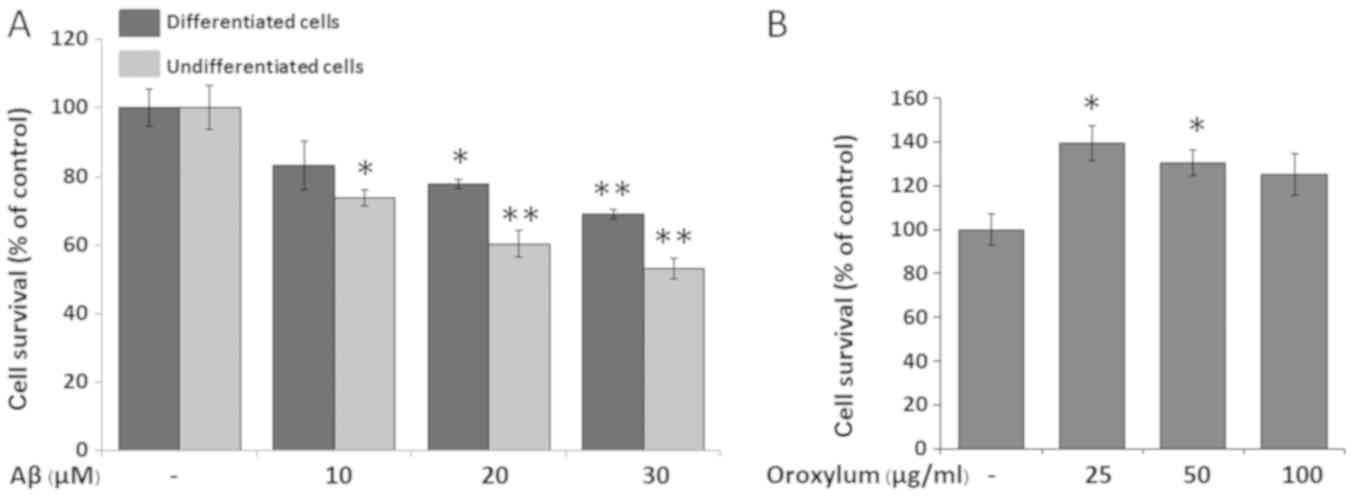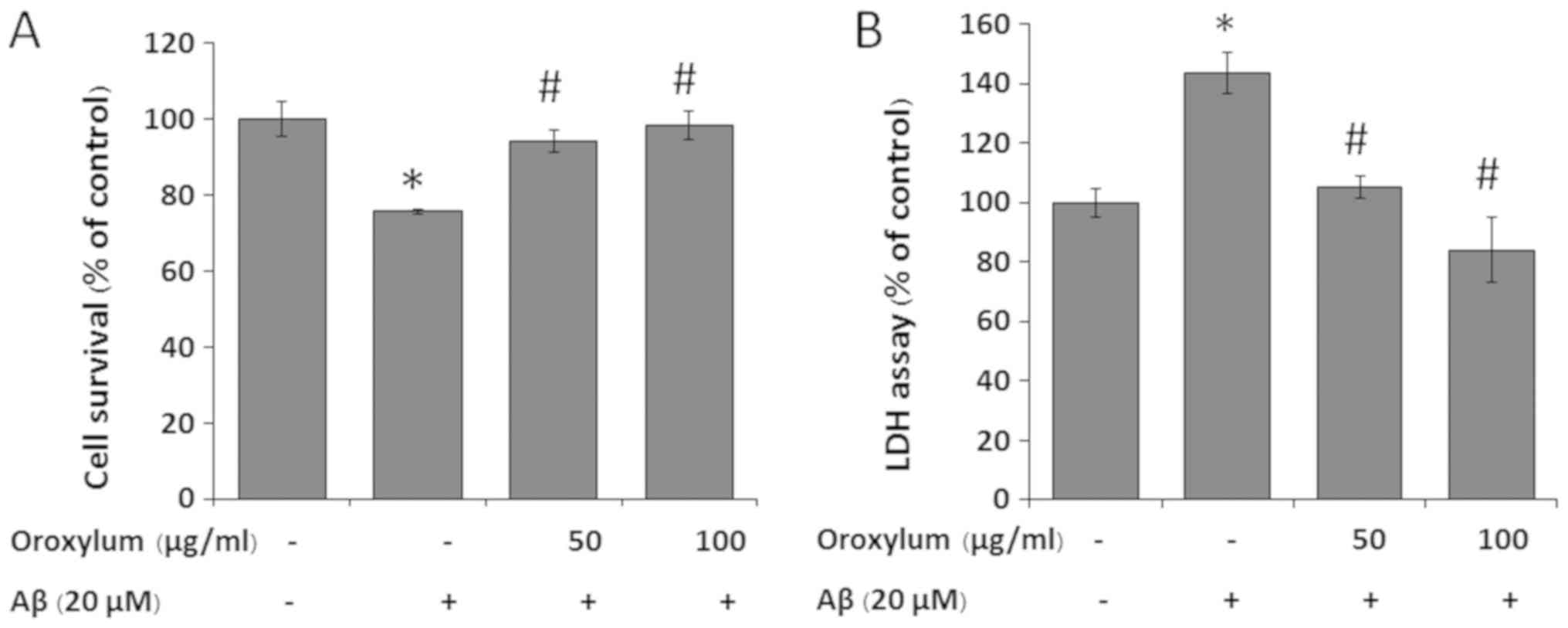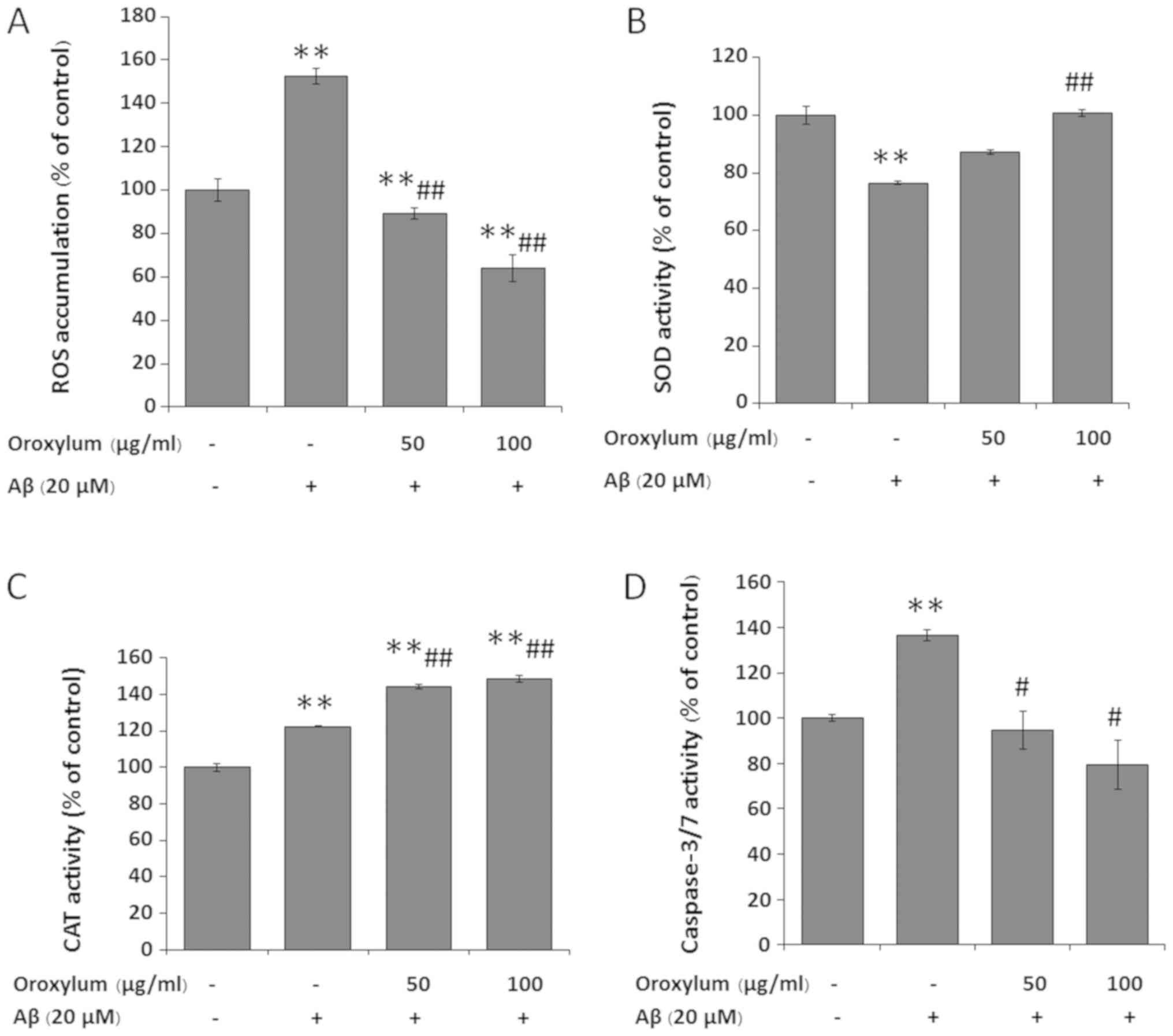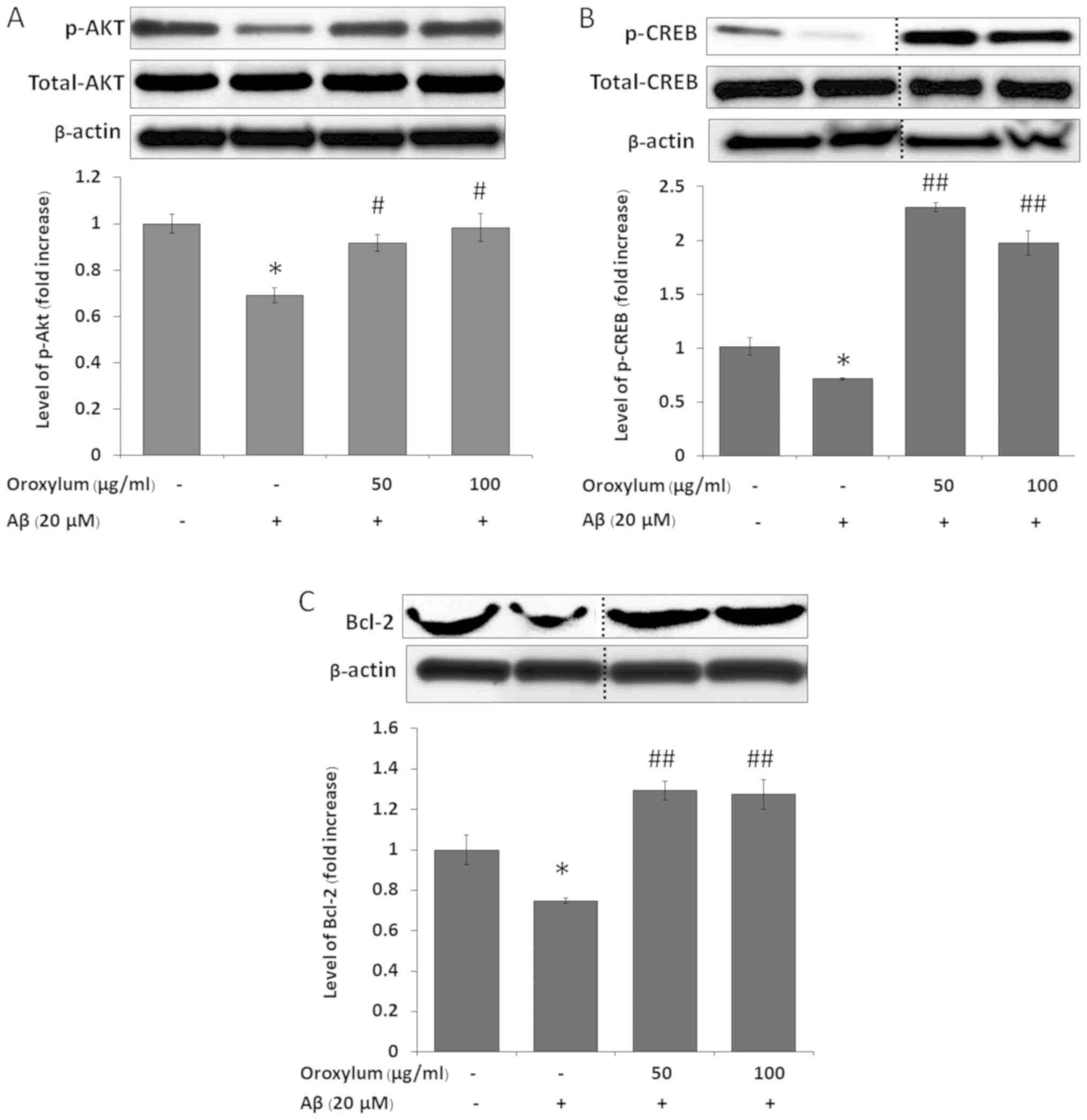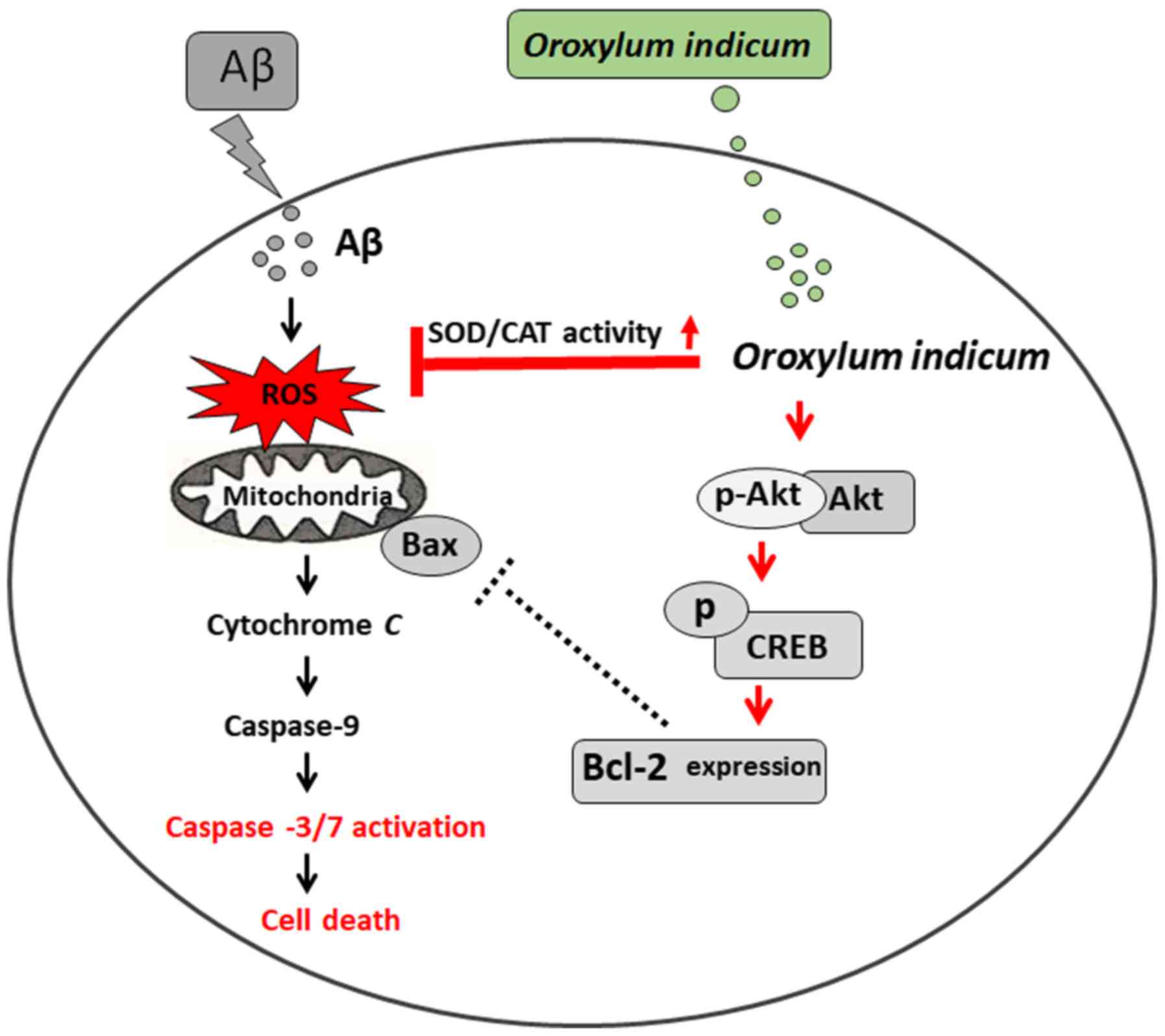|
1
|
Querfurth HW and LaFerla FM: Alzheimer's
disease. N Engl J Med. 362:329–344. 2010. View Article : Google Scholar : PubMed/NCBI
|
|
2
|
Paulson JB, Ramsden M, Forster C, Sherman
MA, McGowan E and Ashe KH: Amyloid plaque and neurofibrillary
tangle pathology in a regulatable mouse model of Alzheimer's
disease. Am J Pathol. 173:762–772. 2008. View Article : Google Scholar : PubMed/NCBI
|
|
3
|
Butterfield DA, Drake J, Pocernich C and
Castegna A: Evidence of oxidative damage in Alzheimer's disease
brain: Central role for amyloid beta-peptide. Trends Mol Med.
7:548–554. 2001. View Article : Google Scholar : PubMed/NCBI
|
|
4
|
Butterfield DA, Griffin S, Munch G and
Pasinetti GM: Amyloid beta-peptide and amyloid pathology are
central to the oxidative stress and inflammatory cascades under
which Alzheimer's disease brain exists. J Alzheimers Dis.
4:193–201. 2002. View Article : Google Scholar : PubMed/NCBI
|
|
5
|
Butterfield DA, Swomley AM and Sultana R:
Amyloid beta-peptide (1–42)-induced oxidative stress in Alzheimer
disease: Importance in disease pathogenesis and progression.
Antioxid Redox Signal. 19:823–835. 2013. View Article : Google Scholar : PubMed/NCBI
|
|
6
|
Bharadwaj PR, Dubey AK, Masters CL,
Martins RN and Macreadie IG: Abeta aggregation and possible
implications in Alzheimer's disease pathogenesis. J Cell Mol Med.
13:412–421. 2009. View Article : Google Scholar : PubMed/NCBI
|
|
7
|
Gray CW and Patel AJ: Neurodegeneration
mediated by glutamate and beta-amyloid peptide: A comparison and
possible interaction. Brain research. 691:169–179. 1995. View Article : Google Scholar : PubMed/NCBI
|
|
8
|
Ueda K, Shinohara S, Yagami T, Asakura K
and Kawasaki K: Amyloid beta protein potentiates Ca2+
influx through L-type voltage-sensitive Ca2+ channels: A
possible involvement of free radicals. J Neurochem. 68:265–271.
1997. View Article : Google Scholar : PubMed/NCBI
|
|
9
|
Muthaiyah B, Essa MM, Chauhan V and
Chauhan A: Protective effects of walnut extract against amyloid
beta peptide-induced cell death and oxidative stress in PC12 cells.
Neurochem Res. 36:2096–2103. 2011. View Article : Google Scholar : PubMed/NCBI
|
|
10
|
Mohd Sairazi NS, Sirajudeen KN, Asari MA,
Muzaimi M, Mummedy S and Sulaiman SA: Kainic acid-induced
excitotoxicity experimental model: protective merits of natural
products and plant extracts. Evid Based Complement Alternat Med.
2015:9726232015. View Article : Google Scholar : PubMed/NCBI
|
|
11
|
Solanki I, Parihar P, Mansuri ML and
Parihar MS: Flavonoid-based therapies in the early management of
neurodegenerative diseases. Adv Nutr. 6:64–72. 2015. View Article : Google Scholar : PubMed/NCBI
|
|
12
|
Venkatesan R, Ji E and Kim SY:
Phytochemicals that regulate neurodegenerative disease by targeting
neurotrophins: A comprehensive review. Biomed Res Int.
2015:8140682015. View Article : Google Scholar : PubMed/NCBI
|
|
13
|
Nootchanat MPC, Chalisa LC and Walaiporn
T: Okra (Abelmoschus esculentus Linn) inhibits
lipopolysaccharide-induced inflammatory mediators in BV2 microglial
cells. Tropical J Pharmaceutical Res. 16:1285–1295. 2017.
View Article : Google Scholar
|
|
14
|
World Health Organization: General
Guidelines for Methodologies on Research and Evaluation of
Traditional Medicine. WHO; Geneva, Switzerland: 2000
|
|
15
|
Lawania RD, Mishra A and Gupta R: Oroxylum
indicum: A Review. Pharm J. 2:304–310. 2010.
|
|
16
|
Narisa K, Wilkinson JM and Cavanagh H:
Cytotoxic effect of four thai edible plants on mammalian cell
proliferation. Thai Pharm Health Sci J. 1:189–195. 2006.
|
|
17
|
Jiwajinda S, Santisopasri V, Murakami A,
Kim OK, Kim HW and Ohigashi H: Suppressive effects of edible thai
plants on superoxide and nitric oxide generation. Asian Pac J
Cancer Prev. 3:215–223. 2002.PubMed/NCBI
|
|
18
|
Diaz P, Jeong SC, Lee S, Khoo C and
Koyyalamudi SR: Antioxidant and anti-inflammatory activities of
selected medicinal plants and fungi containing phenolic and
flavonoid compounds. Chin Med. 7:262012. View Article : Google Scholar : PubMed/NCBI
|
|
19
|
Yan SD, Fu J, Soto C, Chen X, Zhu H,
Al-Mohanna F, Collison K, Zhu A, Stern E, Saido T, et al: An
intracellular protein that binds amyloid-beta peptide and mediates
neurotoxicity in Alzheimer's disease. Nature. 389:689–695. 1997.
View Article : Google Scholar : PubMed/NCBI
|
|
20
|
Kaminsky YG, Tikhonova LA and Kosenko EA:
Critical analysis of Alzheimer's amyloid-beta toxicity to
mitochondria. Front Biosci (Landmark Ed). 20:173–197. 2015.
View Article : Google Scholar : PubMed/NCBI
|
|
21
|
Hughes E, Burke RM and Doig AJ: Inhibition
of toxicity in the beta-amyloid peptide fragment beta-(25–35) using
N-methylated derivatives: A general strategy to prevent amyloid
formation. J Biol Chem. 275:25109–25115. 2000. View Article : Google Scholar : PubMed/NCBI
|
|
22
|
Liu YQ, Jia MQ, Xie ZH, Liu XF, Hui Y and
Zheng XL: Arrestins contribute to amyloid beta-induced cell death
via modulation of autophagy and the alpha7nAch receptor in SH-SY5Y
cells. Sci Rep. 7:34462017. View Article : Google Scholar : PubMed/NCBI
|
|
23
|
Shipley MM, Mangold CA and Szpara ML:
Differentiation of the SH-SY5Y human neuroblastoma cell line. J Vis
Exp. 531932016.PubMed/NCBI
|
|
24
|
Wang Y, Miao Y, Mir AZ, Cheng L, Wang L,
Zhao L, Cui Q, Zhao W and Wang H: Inhibition of
beta-amyloid-induced neurotoxicity by pinocembrin through Nrf2/HO-1
pathway in SH-SY5Y cells. J Neurol Sci. 368:223–230. 2016.
View Article : Google Scholar : PubMed/NCBI
|
|
25
|
Liu XY, Wang LX, Chen Z and Liu LB:
Liraglutide prevents beta-amyloid-induced neurotoxicity in SH-SY5Y
cells via a PI3K-dependent signaling pathway. Neurol Res.
38:313–319. 2016. View Article : Google Scholar : PubMed/NCBI
|
|
26
|
Sarkar B, Dhiman M, Mittal S and Mantha
AK: Curcumin revitalizes Amyloid beta (25–35)-induced and
organophosphate pesticides pestered neurotoxicity in SH-SY5Y and
IMR-32 cells via activation of APE1 and Nrf2. Metab Brain Dis.
32:2045–2061. 2017. View Article : Google Scholar : PubMed/NCBI
|
|
27
|
Deshpande A, Mina E, Glabe C and Busciglio
J: Different conformations of amyloid beta induce neurotoxicity by
distinct mechanisms in human cortical neurons. J Neurosci.
26:6011–6018. 2006. View Article : Google Scholar : PubMed/NCBI
|
|
28
|
He Y, Cui J, Lee JC, Ding S, Chalimoniuk
M, Simonyi A, Sun AY, Gu Z, Weisman GA, Wood WG and Sun GY:
Prolonged exposure of cortical neurons to oligomeric amyloid-β
impairs NMDA receptor function via NADPH oxidase-mediated ROS
production: Protective effect of green tea
(−)-epigallocatechin-3-gallate. ASN Neuro. 3:e000502011.PubMed/NCBI
|
|
29
|
Sponne I, Fifre A, Koziel V, Oster T,
Olivier JL and Pillot T: Membrane cholesterol interferes with
neuronal apoptosis induced by soluble oligomers but not fibrils of
amyloid-beta peptide. FASEB J. 18:836–838. 2004. View Article : Google Scholar : PubMed/NCBI
|
|
30
|
Shelat PB, Chalimoniuk M, Wang JH,
Strosznajder JB, Lee JC, Sun AY, Simonyi A and Sun GY: Amyloid beta
peptide and NMDA induce ROS from NADPH oxidase and AA release from
cytosolic phospholipase A2 in cortical neurons. J Neurochem.
106:45–55. 2008. View Article : Google Scholar : PubMed/NCBI
|
|
31
|
Pate KM, Rogers M, Reed JW, van der Munnik
N, Vance SZ and Moss MA: Anthoxanthin polyphenols Attenuate Aβ
oligomer-induced neuronal responses associated with alzheimer's
disease. CNS Neurosci Ther. 23:135–144. 2017. View Article : Google Scholar : PubMed/NCBI
|
|
32
|
Allan LA, Morrice N, Brady S, Magee G,
Pathak S and Clarke PR: Inhibition of caspase-9 through
phosphorylation at Thr 125 by ERK MAPK. Nat Cell Biol. 5:647–654.
2003. View Article : Google Scholar : PubMed/NCBI
|
|
33
|
Hermann C, Assmus B, Urbich C, Zeiher AM
and Dimmeler S: Insulin-mediated stimulation of protein kinase Akt:
A potent survival signaling cascade for endothelial cells.
Arterioscler Thromb Vasc Biol. 20:402–409. 2000. View Article : Google Scholar : PubMed/NCBI
|
|
34
|
Kitazumi I and Tsukahara M: Regulation of
DNA fragmentation: The role of caspases and phosphorylation. FEBS
J. 278:427–441. 2011. View Article : Google Scholar : PubMed/NCBI
|
|
35
|
Bonni A, Brunet A, West AE, Datta SR,
Takasu MA and Greenberg ME: Cell survival promoted by the Ras-MAPK
signaling pathway by transcription-dependent and -independent
mechanisms. Science. 286:1358–1362. 1999. View Article : Google Scholar : PubMed/NCBI
|
|
36
|
Pugazhenthi S, Miller E, Sable C, Young P,
Heidenreich KA, Boxer LM and Reusch JE: Insulin-like growth
factor-I induces bcl-2 promoter through the transcription factor
cAMP-response element-binding protein. J Biol Chem.
274:27529–27535. 1999. View Article : Google Scholar : PubMed/NCBI
|
|
37
|
Wilson BE, Mochon E and Boxer LM:
Induction of bcl-2 expression by phosphorylated CREB proteins
during B-cell activation and rescue from apoptosis. Mol Cell Biol.
16:5546–5556. 1996. View Article : Google Scholar : PubMed/NCBI
|
|
38
|
Hwang S, Lim JW and Kim H: Inhibitory
effect of lycopene on amyloid-β-induced apoptosis in neuronal
cells. Nutrients. 9(pii): E8832017. View Article : Google Scholar : PubMed/NCBI
|
|
39
|
Wang H, Xu Y, Yan J, Zhao X, Sun X, Zhang
Y, Guo J and Zhu C: Acteoside protects human neuroblastoma SH-SY5Y
cells against beta-amyloid-induced cell injury. Brain Res.
1283:139–147. 2009. View Article : Google Scholar : PubMed/NCBI
|
|
40
|
Ratty AK and Das NP: Effects of flavonoids
on nonenzymatic lipid peroxidation: Structure-activity
relationship. Biochem Med Metab Biol. 39:69–79. 1988. View Article : Google Scholar : PubMed/NCBI
|
|
41
|
Olsvik PA, Kristensen T, Waagbo R,
Rosseland BO, Tollefsen KE, Baeverfjord G and Berntssen MH: mRNA
expression of antioxidant enzymes (SOD, CAT and GSH-Px) and lipid
peroxidative stress in liver of Atlantic salmon (Salmo salar)
exposed to hyperoxic water during smoltification. Comp Biochem
Physiol C Toxicol Pharmacol. 141:314–323. 2005. View Article : Google Scholar : PubMed/NCBI
|
|
42
|
Tong Y, Bai L, Gong R, Chuan J, Duan X and
Zhu Y: Shikonin protects PC12 cells against β-amyloid
peptide-induced cell injury through antioxidant and antiapoptotic
activities. Sci Rep. 8:262018. View Article : Google Scholar : PubMed/NCBI
|
|
43
|
Behl C, Davis JB, Lesley R and Schubert D:
Hydrogen peroxide mediates amyloid beta protein toxicity. Cell.
77:817–827. 1994. View Article : Google Scholar : PubMed/NCBI
|
|
44
|
Shaw RJ and Cantley LC: Ras, PI(3)K and
mTOR signalling controls tumour cell growth. Nature. 441:424–430.
2006. View Article : Google Scholar : PubMed/NCBI
|
|
45
|
Pugazhenthi S, Nesterova A, Sable C,
Heidenreich KA, Boxer LM, Heasley LE and Reusch JE: Akt/protein
kinase B up-regulates Bcl-2 expression through cAMP-response
element-binding protein. J Biol Chem. 275:10761–10766. 2000.
View Article : Google Scholar : PubMed/NCBI
|
|
46
|
Magrane J, Rosen KM, Smith RC, Walsh K,
Gouras GK and Querfurth HW: Intraneuronal beta-amyloid expression
downregulates the Akt survival pathway and blunts the stress
response. J Neurosci. 25:10960–10969. 2005. View Article : Google Scholar : PubMed/NCBI
|
|
47
|
Sastry AVS, Girija Sastry V, Mallikarjun P
and Srinivas K: Chemical and pharmacological evaluation of aqueous
extract of root bark of ‘Oroxylum indicum’ vent. Int J Pharm
Technol. 3:1796–1806. 2011.
|
|
48
|
Sreedevi Adikay, Usha Rani U and Bharathi
Koganti: Protective effect of ethanolic extract of Oroxylum indicum
against cisplatin-induced acute renal failure. Int J Pharm Therap.
2:48–53. 2011.
|
|
49
|
Tenpe R, Aman U, Burle S and Yeole YG: In
vitro antioxidant and preliminary hepatoprotective activity of
Oroxylum indicum Vent leaf extracts. Pharmacologyonline. 1:35–43.
2009.
|
|
50
|
Bichitra Nanda Tripathy, Panda SK, Sahoo
S, Mishra SK and Nayak L: Phytochemical analysis and
hepatoprotective effect of stem bark of Oroxylum indicum (L) Vent.
On carbon tetrachloride induced hepatotoxicity in rat. Int J Pharma
Biol Arc. 2:1714–1717. 2011.
|
|
51
|
Kevalkumar R, Rathod, Rashmi CA, Miloni JK
and Tejas HG: Evaluation of effect of Oroxylum indicum leaves on
central nervous system with special emphasis on epilepsy. J
Chemical Pharm Res. 8:680–685. 2016.
|
|
52
|
Varadarajan S, Yatin S, Aksenova M and
Butterfield DA: Review: Alzheimer's amyloid beta-peptideassociated
free radical oxidative stress and neurotoxicity. J Struct Biol.
130:184–208. 2000. View Article : Google Scholar : PubMed/NCBI
|
|
53
|
Butterfield DA: Beta-Amyloid-associated
free radical oxidative stress and neurotoxicity: Implications for
Alzheimer's disease. Chem Res Toxicol. 10:495–506. 1997. View Article : Google Scholar : PubMed/NCBI
|
|
54
|
Redza-Dutordoir M and Averill-Bates DA:
Activation of apoptosis signalling pathways by reactive oxygen
species. Biochim Biophys Acta. 1863:2977–2992. 2016. View Article : Google Scholar : PubMed/NCBI
|















